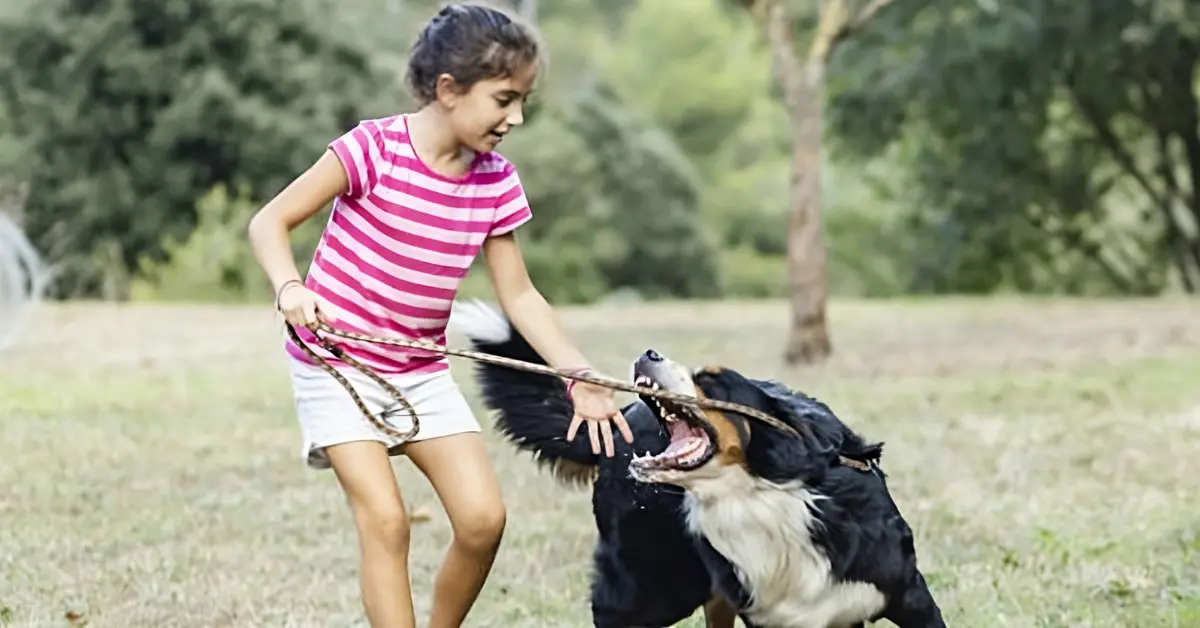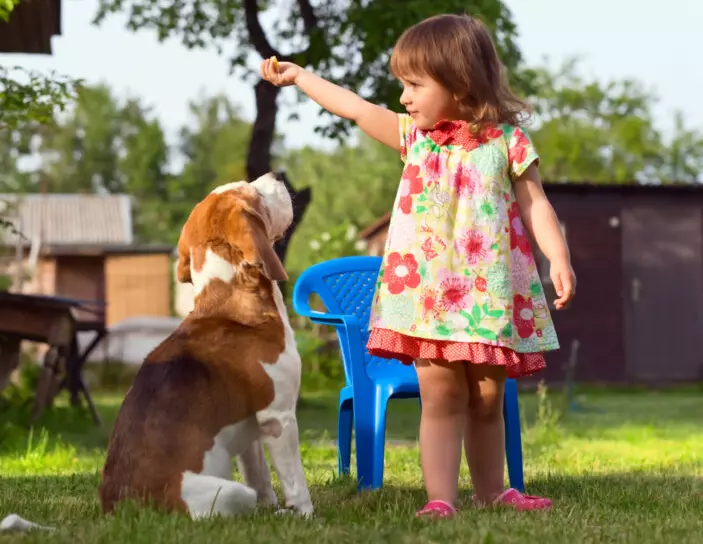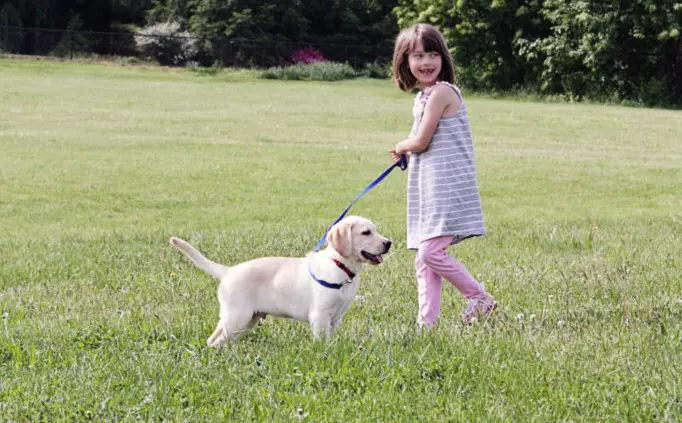Dog Bites Child: Provoked vs Unprovoked Dog Bite
Dog bites a child: when can a child be found to have provoked a dog? In terms of provocation with children, state laws have different points. Common sense would tell you how children react whenever they see dogs; they’re known for grabbing, pulling, and squeezing dogs.
However, it seemed like the protection is always in favor of children who provoke, not the dog. This being said, as the dog owner, you have the responsibility to give optimum protection to the child against your dog. The question is: is the dog also protected by the law? That question will be answered later on.

Indeed, injuries from dog bites are usual. The sad news is that children are more affected than adults. Just come to imagine that there is about a 50% chance a child sustains a dog bite, and around 80% of which is severe (one that involves neck and head) according to statistics.
There are varying laws among different states; we have to know about these laws first before discussing whether or not a child is considered to have provoked a dog. Read along, and you will understand!
Law Governing Liability For Damages Caused By Dogs

Here are the laws showing the presumption that children at a certain age don’t cause provocation, resulting in liability of owners in case of dog bites:
-
Massachusetts
Under Massachusetts General Law – Part I, Title XX, Chapter 140, Section 155, the general rule is that the owner is liable for the damages caused, either the body or the property of another, by the dog.
However, there is an exception to this liability, such as when the person trespassed, committed other torts, teased, tormented, or abused the dog. As an exception to this exception, it is presumed that a child under seven years of age does not commit the said acts. The burden of proof to reverse the presumption is in the defendant.
You see, this law only shows that a child who’s under seven years of age is presumed not to have provoked a dog. Playing and petting with dogs are undoubtedly exciting for many children. Who could resist teasing their pets? Sometimes, it seemed like children hurt dogs; in fact, they’re just playing with them.
As a result, dogs would bite them. It was found out that one percent of emergencies is due to bite wounds, the majority of which is dog bites. Sadly, around 15 to 30 percent of these cases involve dogs belonging to the family. Although numerous cases of dog bites are only minor cases, those which involve severe injuries are scary.
What’s worse is that most cases require the dog owner to pay for damages to the victim. How about the protection of dogs in this case? Are these animals really protected? Should they be entirely blamed? Well, not all the time! There are laws protecting dogs, especially if they’re provoked.
-
Connecticut’s presumption
According to Connecticut’s law on the damage by dogs to persons or property, there’s a presumption that there’s no provocation if the one who provoked is under seven years of age.
This law speaks about the liability for damage by the owner or keeper of the dog causing damage to the body or property of another.
However, there’s no liability to speak of when the said damage was obtained due to trespassing or the commission of a tort by the victim. Furthermore, liability is not commenced when the victim teased, tormented, or abused the dog.
Just like the law above mentioned, there’s an exception to this exception: it is presumed that the said acts are not committed when the child is under 7 years of age. In this case, the burden of proof is given to the defendant.
Cases Involved
To further understand the laws regarding children and dog bites and how they’re applied, let’s look at the cases below:
-
The presumptions ARE rebuttable
In the case of Reed by Through Lawrence v. Bowen, No. 86-182, October 24, 1986, the appellants (plaintiffs) seek damages resulted from the attack of the dog of the appellees (dog owner). Indeed, it was established that the dog is owned by the appellees, the Bowens’, and that the child is lawfully on their property.
However, the issue herein is whether or not the child acted carelessly or mischievously, thereby aggravating or provoking the dog.
According to the facts of the case, the child (who was only 4 years old) went to the Bowens’ and played with the dog in their yard. However, Mrs. Bowens gave a warning not to play with the dog because it has an ear infection. But then, the child insisted on playing so, he was asked to go home.
When the child left, the Bowens went inside the house. However, a neighbour testified that she saw the child returned to the yard. Although she can’t entirely see what has just happened, he presumed that the child was pulling either the chain of the dog or the dog itself. The dog turned and bit the child.
In this case, the law does not always rule in favor of the injured. This case shows the presumption that a child under 7 years of age is deemed not provoked the dog is rebuttable. It manifests that the Florida courts do not agree with an automatic presumption, thereby concluding that the 4-year-old child provoked the dog.
In deciding thereof, it is crucial to take note of all the circumstances of the incident (such as the maturity and age of the child). Since it is shown that the child aggravated and provoked the dog, the conclusive presumption of contributory negligence is not considered in the case.
-
Acts constituting provocation, thus no automatic presumption protecting the child
Here’s another case constituting provocation by a three and a half-year-old child. In the case of Toney v. Bouthillier, 631 P.2d 557 (Ariz. Ct. App. 1981), the issue raised therein (relevant to our discussion) is whether or not the acts of the child constitutes provocation.
The facts show that while the child (who was three years and eight months of age) was on a public sidewalk playing, a German shepherd bit her. At that time, the dog was roaming around the neighborhood since it was unleashed. Due to the bite, the child suffered from a nose laceration, requiring three surgeries.
Arizona law, in this case, teaches us that hitting a dog could result in a finding of provocation; thus, there is no automatic presumption (that the child does not cause the provocation) protecting the child. It is worth noting that provocation here is shown when the child hit a “bad dog.”
-
No automatic presumtion
In the case of Nelson v. Lewis, 36 Ill. App. 3d 130, 344 N.E.2d 268 (Ill. App. Ct. 1976), the injury caused to the two and a half-year-old child is not compensable. Why so? The child is deemed to have provoked the dog by stepping on its tail.
Under Illinois law, there’s no exemption from liability if the child provoked the dog. If you’re wondering what provocation means, it is the process or act of provoking (of course), incitement, or stimulation.
At common law, it is a must for the plaintiff to show that the dog is acting viciously towards another person. And this disposition should be known to the owner. please read here Why Is My Dog Acting Paranoid All of a Sudden
However, the burden imposed by the law is reduced by the adoption of the statute under the Animal Control Act.
Furthermore, there are two kinds of provocation- intentional and unintentional. The court holds that unintentional provocation entitles the victim to recover from the injuries suffered; provided that the animal’s response is too extreme in relation to the stimulus.
-
Provocation barring relief
In the case of Nicholes v. Lorenz, 237 N.W.2d 468 (Mich. 1976), it holds that the past conduct of the dog or the knowledge of the owner thereof is not necessary to establish; such statement is true if you bring an action under the dog bite statute.
The Supreme Court of Michigan requires that for a person to be liable, it should determine whether the inadvertent act (of stepping on the tail) constitutes provocation. Well, in this case, there is no evidence showing that the provocation was intentional.
However, the act of a six-year-old child pushing a seven-year-old could lead to provocation, thereby barring relief from the injury caused by the dog.
As one can see, the facts of an animal attack or dog bite case are very much considered on a case-by-case basis. Please read here: Dog Bite Cases in New York
Myths About Dog Safety

Yes, we have a pet-centered society. I guess you also have your own dogs at home. But then, it’s sad to think that commonly, we don’t know safety practices that we can apply, both dog owners and parents.
And we can’t just assume that there are adequate safety practices available at home. Here are the common myths about children and dogs:
Myth #1. Suppose dogs are already familiar to children while still puppies, they won’t bite as they grow old.
Here are the common reasons why dogs bite children:
- Resource guarding
- Fear
- Pain
- Benign interactions (like hugging and petting)
While puppies are around 3 to 12 weeks old, they are sensitive. You have to take note of this stage as puppies need to feel safe all the time. Exposing your children to these puppies may be dangerous.
The cure for resource guarding is not entirely through socialization. It’s hard if your dog is quite insecure about its food. Yes, your child and your pet grow up comfortable with each other. But it doesn’t mean that it won’t hurt your child, especially when it feels startled, hurt, or scared.
Myth #2. Dogs are safe with adults; thus, they’re safe with children too.
The difference in how adults and children act is significant. Dogs observe the difference in how children (pre-schoolers, toddlers, babies, or newborns) act, interact, and sound.
With this, there’s no doubt why dogs can get worried when children are around.
Myth #3. Children are taught to discipline the dog so that it will submit to them.
The humans and dogs relationship is not a competition for purposes of social dominance. As mentioned many times, the common reason why dog bites are because of resource guarding or fear, not conflicts regarding dominance. Please read also: Do Guard Dogs Automatically Have Vicious Propensities
For instance, your dog growls at a child, and the latter yells in the negative. This action alone escalates aggression, not just in the present but also in future encounters.
Also, if a dog is anxious, it will most likely become defensive to your child’s “threats.”
Myth #4. Children can be gentle; there’s nothing to worry about.
Here are the acts triggering dog bites:
- Hugging
- Petting
- Touching
- Kissing
Have you observed that these are affectionate and gentle acts?
Well, humans and dogs have different languages. For example, dogs interpret eye to eye contact as a threat, mainly if the other dog rests. Why so? The one who’s resting may signal anxiety or stress by yawing, licking its lips, or looking away. The approaching dog may feel the same way.
Don’t overlook these simple warning signs. If your child still approaches a “threatened” dog, he will most likely be bitten.
Myth #5. All dogs, aside from a pit bull, is safe with children.
Any dog can bite your child (whatever breed or mix it is). And dog bites are inevitable every day.
According to a study, here are the common breeds that usually bite familiar children:
- Yorkshire terriers
- Shih Tzus
- Labrador retrievers
And what does this study shows? It only means that pit bulls are not included herein. In short, all kinds of breeds can bite your children.
Myth #6. Since pit bulls are nanny dogs, they’re safe with children.
Then and again, any dog can bite, which means there’s no such thing as a “childproof” dog.
Myth #7. A dog that’s wagging its tail won’t bite a child.
Your dog’s behavior is sometimes unpredictable. For us humans, kissing does not indicate an adverse action. But for dogs, it may be a sign of motivational conflict, anxiety displacement, or fear.
For instance, your dog is sleeping, and your child stepped on its foot. When the dog awakens, it may lick your child. The act of licking may be a sign of worry. Sometimes, it indicates that it wants the child to go away. Please read here why does my dog lick me in the morning
Prevention Of Dog Bites

It is inherent for all pets to cause injury, whether or not intentional. Without a doubt, it’s common for them to bite, especially to those pets with canine behavior.
According to a study, German shepherds, Labrador retrievers, English springer spaniels, American cocker spaniels, and golden retrievers are breeds that frequently bite children.
There are many reasons why dogs bite. And this situation drives fear as well as pain, which triggers children to be aggressive. Yes, adults are usual victims of dog bites, but severe ones are usually inflicted on children. Usually, children are bitten in the face and head compared to adults.
Here are the reasons why children tend to be at risk of dog bites:
a) For babies and toddlers
Dogs may get intimidated by babies and toddlers because of their utmost mobility. They keep on walking, climbing, rolling over, and reaching. Even if dogs are familiar to your child for a few years already, the child’s new mobility may lead to the dog’s aggression.
Here are the warning signs:
- Avoids toddler (the dog just walks away)
- Growls at the child whenever he stares or approaches the dog
- Manifests anxiety
b) For young children
If you have a young child, such as one in the preschool years, you would understand how loud, impulsive, oblivious, and fast-moving he can be. For sure, children love to hug the dog, hold its head, or even disturb its sleep.
These children can’t follow instructions for safety. That’s why there’s no doubt why they get bitten by a dog, even if it’s their family pet. Moreover, these ages tend to be more independent than toddlers, making supervision less likely than the younger ones.
A child petting, hugging, reaching, lying, or staring can provoke aggression from a dog’s standpoint.
Here are the warning signs:
- Licks lips
- Growls
- Looks away
- Attempts to walk away
c) For older children
It’s more likely for older children to get bitten outdoors, which means that dogs are usually unknown to them. Most of the time, dogs initiate the interaction. In these instances, you might not have manifest warning signs, like staring.
Perhaps, it is worth emphasizing that prevention should involve combining safety practices and community efforts.
You may say that the bite was entirely unprovoked. Well, it’s always misunderstood. All bites are provoked. Though there are exceptions when they suffer from irritable behavior because of neurologic or systemic disease or pain. Yes, bites may be due to a particular trigger which you can’t prevent
As I said, merely reaching toward, approaching, or bending near a dog is already provocative for them.
Dog Bites Law: Are You Liable?

Here’s a question:
Your kid poked your dog. Would you be liable?
Actually, the answer depends on the law of your state.
The first question is whether every dog gets one bite and the second question is whether or not the dog is provoked when it bit the child.
In general, the owner must have prior knowledge of the dog’s tendency to bite. However, some laws do not necessitate knowledge, thereby giving liability to owners; this law is dubbed the “strict liability” law.
Some states exempt dog owners from liability if there is an intentional provocation on the victim’s part.
Anyway, liability is commonly based on negligence on the owner’s part. The recovery, on the other hand, is based on the act of the owner. If you are not aware of what we call common law, it’s the law based on historical traditions and court decisions rather than statutory provisions.
A person could recover from injury if it were shown that the party has a legal duty owed to the other as the owner and that the injury resulted due to breach of such duty.
There is a breach of such duty if the owner or keeper:
- Failed to secure the dog;
- Entrusted the dog to someone not capable of restraining it; or
- Violated a local ordinance (like mandatory muzzling or dogs running at large prohibition).
So, a person is presumed negligent for not keeping the dog secure from causing damage to another. Given that such person has knowledge of its vicious and savage nature.
Here are the common questions the court may ask to determine the owner’s negligence:
- Does the act of dog within the “dangerous activities” provided by the law?
- Does the owner know, actually or constructively, of the dog’s propensity?
- Does the dog show propensity to act this way prior to the incident?
- Does the dangerous act of the dog result in harm?
Showing the existence of a prior tendency or propensity is necessary. Considering fairness, the lawmakers would not want owners to be liable for their dog’s actions unless there’s a notice of its tendency to commit dangerous activity.
In states with strict liability, there is no need to prove the owner’s negligence; it is enough that the dog is known to have the propensity to bite, injure, attack, or chase someone.
Provocation is a crucial fact in a case as it serves as a defense either to reduce or even bar the owner’s liability. So, let’s go back to the sample case. The act of the child poking the dog constitutes provocation.
Depending on the child’s age, however, the court may presume that there’s no provocation on his part (which depends on the law applied to your state).
It’s A Wrap!
Children and dog bites: when can a child be found to have provoked a dog?
Depending on the child’s age and action, he may be deemed to have provoked a dog. As I mentioned above, there’s no provocation when the child is at a certain age. And if this is shown, the owner will be liable for the injury suffered.
However, if it is shown that there’s a provocation on the victim’s part and his age is not among the exemptions, the owner’s liability may be reduced or waived.
Hopefully, you’ve learned a lot from this article. Don’t forget to be a responsible pet owner, okay?
